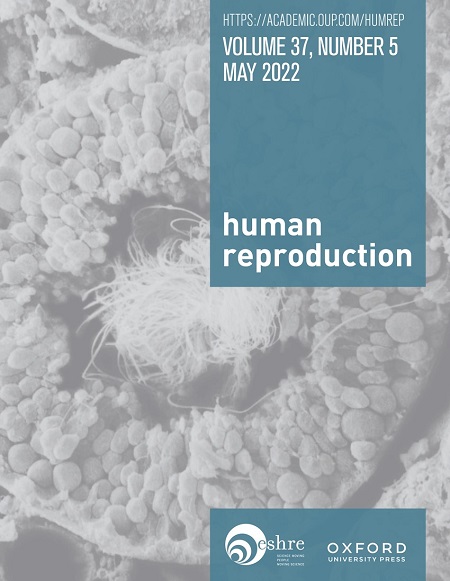实时监测揭示了胚胎学实验室低浓度挥发性有机化合物的影响
IF 6
1区 医学
Q1 OBSTETRICS & GYNECOLOGY
引用次数: 0
摘要
研究问题:胚胎学实验室对挥发性有机化合物(VOCs)的实时监测能否为潜在的环境危害提供有意义的早期预警?即使在总挥发性有机化合物浓度低于开罗共识建议的实验室环境中,实时监测的挥发性有机化合物浓度也与胚胎形态参数的变化有关。在胚胎学实验室中,挥发性有机化合物被认为是一个关键的环境危害。然而,目前由开罗共识建立的VOC阈值是基于空气污染案例的实际经验,缺乏科学推导的阈值。研究包括2020年6月至2022年12月在厦门大学附属呈呈宫医院生殖医学中心进行的7076个卵母细胞收集(OPU)周期,其中6306个周期在研究期间至少进行了一次胚胎移植(ET)尝试。每10分钟记录一次VOC监测数据。培养过程中总VOC和甲醛的平均浓度和峰值浓度与胚胎参数和植入周期第一次ET尝试后的广义估计方程和广义加性模型相关联。VOCs实时监测显示了实验室VOC浓度的动态变化。浓度在工作日和工作日达到峰值,在夜间和周末迅速下降。培养期间VOCs的平均浓度与早期卵裂减少(OR 0.92, 95% CI: 0.85, 0.99)、第3天压实减少(OR 0.51, 95% CI: 0.32, 0.83)、不对称增加(OR 1.13, 95% CI: 1.01, 1.25)和C级滋养外胚(TE)增加(OR 1.99, 95% CI: 1.32, 3.01)呈线性相关。另一方面,第3天骤停增加、囊胚形成延迟和A级TE降低与VOCs呈非线性相关,提示可能存在影响阈值。在第一次转移中,在新鲜转移(RR 0.971, 95% CI: 0.94, 0.99)和冷冻-所有冻融ET (RR 0.959, 95% CI: 0.92, 0.99)周期中,观察到最大甲醛浓度与妊娠之间呈负相关。该监测器的灵敏度和特异性不能与标准方案(如色谱-质谱)相比。由于缺乏识别挥发性有机化合物成分的化学性质的能力,挥发性有机化合物的毒性和来源在很大程度上是未知的。实验室空气的代表性采样不一定反映胚胎的暴露情况。虽然胚胎学实验室的环境已经得到了显著改善,但数据表明,低VOC水平仍然是一个问题。由于实验室空气中挥发性有机化合物的浓度是动态的,定期监测可能无法捕捉到增加的挥发性有机化合物水平,并发出早期警报。国家自然科学基金项目[批准号:22176159]、厦门市医学优势亚专业建设项目[批准号:2018296]、吴杰平医学基金项目[批准号:320.6750.2024-6-14]资助。所有作者声明没有利益竞争。试验注册号n / a。本文章由计算机程序翻译,如有差异,请以英文原文为准。
Real-time monitoring reveals the effects of low concentrations of volatile organic compounds in the embryology laboratory
STUDY QUESTION Could real-time monitoring of volatile organic compounds (VOCs) in the embryology laboratory provide meaningful early warning for potential harm from the environment? SUMMARY ANSWER Even in a laboratory environment with a total VOC concentration lower than the recommendation of the Cairo Consensus, the real-time monitored VOC concentrations are associated with changes in embryo morphological parameters. WHAT IS KNOWN ALREADY VOCs have been considered a key environmental detriment in embryology laboratories. However, the current VOC thresholds established by the Cairo consensus were based on the practical experience of air pollution cases, and a scientifically derived threshold is lacking. STUDY DESIGN, SIZE, DURATION The study included 7076 oocyte collection (OPU) cycles carried out between June 2020 and December 2022 in the Center for Reproductive Medicine of the affiliated Chenggong Hospital of Xiamen University, 6306 of which resulted in at least one embryo transfer (ET) attempt during the study. VOC monitoring data were recorded every 10 min. The average and peak concentrations of total VOCs and formaldehyde during culture were associated with embryo parameters and implantation following the first ET attempt of the cycle in generalized estimating equations and generalized additive models. MAIN RESULTS AND THE ROLE OF CHANCE Real-time monitoring of VOCs showed a dynamic of VOC concentration in the laboratory. The concentration reached peaks during the working hours of the days and working days of the week and fell quickly at night and on weekends. The average concentrations of VOCs during the culture period were linearly associated with decreased early cleavage (OR 0.92, 95% CI: 0.85, 0.99), decreased Day 3 compaction (OR 0.51, 95% CI: 0.32, 0.83), increased asymmetry (OR 1.13, 95% CI: 1.01, 1.25), and increased grade C trophectoderm (TE) (OR 1.99, 95% CI: 1.32, 3.01). On the other hand, increased Day 3 arrest, delayed blastocyst formation, and decreased grade A TE showed a non-linear association with VOCs, suggesting a possible threshold of effect. In the first transfer attempt, negative associations were observed between maximal formaldehyde concentrations and pregnancy in both fresh transfer (RR 0.971, 95% CI: 0.94, 0.99) and freeze-all frozen-thawed ET (RR 0.959, 95% CI: 0.92, 0.99) cycles. LIMITATIONS, REASONS FOR CAUTION The sensitivity and specificity of the monitor are not comparable to the standard protocols, such as chromatography-mass spectroscopy. Due to the lack of ability to identify the chemical nature of the components of VOCs, the toxicity and source of the VOCs were largely unknown. The representative sampling of the laboratory air may not necessarily reflect the exposure of embryos. WIDER IMPLICATIONS OF THE FINDINGS While the environment of the embryology laboratory has been significantly improved, the data suggested that a low VOC level could still be a concern. Due to the dynamic of VOC concentration in the laboratory air, periodic monitoring may fail to capture the increased VOC levels and give an early alarm. STUDY FUNDING/COMPETING INTEREST(S) This work was supported by the National Natural Science Foundation of China [grant number 22176159], the Xiamen Medical Advantage subspecialty construction project [grant number 2018296], and the Wu Jieping Medical Foundation [grant number 320.6750.2024-6-14]. All authors declare no competing interests. TRIAL REGISTRATION NUMBER N/A.
求助全文
通过发布文献求助,成功后即可免费获取论文全文。
去求助
来源期刊

Human reproduction
医学-妇产科学
CiteScore
10.90
自引率
6.60%
发文量
1369
审稿时长
1 months
期刊介绍:
Human Reproduction features full-length, peer-reviewed papers reporting original research, concise clinical case reports, as well as opinions and debates on topical issues.
Papers published cover the clinical science and medical aspects of reproductive physiology, pathology and endocrinology; including andrology, gonad function, gametogenesis, fertilization, embryo development, implantation, early pregnancy, genetics, genetic diagnosis, oncology, infectious disease, surgery, contraception, infertility treatment, psychology, ethics and social issues.
 求助内容:
求助内容: 应助结果提醒方式:
应助结果提醒方式:


